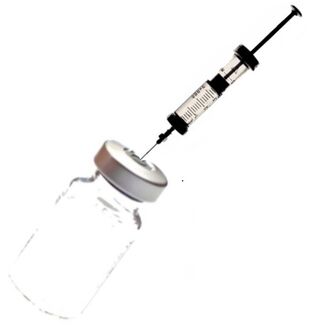Coronavirus Disease 2019
Unbreakable Myths of COVID-19 Vaccines
Why do people believe false information about vaccine ingredients?
Posted April 15, 2021 Reviewed by Lybi Ma
Key points
- As with many myths that are impossible to amend, several involving vaccines are misunderstandings in need of correction.
- There are false claims about the use of heavy metals and fetal tissue in COVID-19 vaccine ingredients.
- There is a dominant belief that vaccine emergency approvals were rushed. We should not be so surprised.

Why do so many people continue to believe that COVID-19 vaccines contain metals and fetal tissue when the evidence clearly shows otherwise?
There is a point when too much has been said about vaccines because nobody is still listening. Now, with almost 125 million people ( 37 percent of the population) partially vaccinated in the US, we are at that point. And still, according to the latest Gallup poll, 26 percent of US residents are hesitant in accepting COVID-19 vaccines for several reasons. Half are adamantly opposed to getting a vaccination. That leaves 85 million Americans vulnerable to a rambling virus likely to mutate into spreading breakthrough contagions.
The mathematics of contamination is simple. We must remember that our initial trouble started with just one person. With so many unprotected people fair game for the virus, a new explosion could begin with just one breakthrough. Already, there are many.
Modern myths are gaining footholds in belief systems. Health care is especially vulnerable to counterfactual trust. The body and the viruses that attempt to attack it are complex structures that take a medical or science degree to fathom. Fifty years ago, it was harder to find scientific material that could address a medical question. Today anyone can browse the Internet and talk to friends who have done the same to find a web of conflicting answers to almost any medical question.
COVID-19 vaccine myths are slowly falling through the colander of conformational bias into the sieves of verity. Too many myths are still in strainers. Counterfactual arguments tend to be almost impossible to erase after gaining a widespread conviction. They become the new conformational biases. And that is where we are today with the too-common belief that COVID-19 vaccines contain heavy metals or even just metals, along with the belief that emergency approvals of COVID-19 vaccines were over-rushed and that fetal tissue is used as an ingredient.
No heavy metals and no fetal tissue
Take the myth of heavy metals. There is so much misinformation worrying people about heavy metals in vaccines. Modern vaccines contain no metals at all, not heavy, not light. To the evangelical concern, they contain no abortive cell tissue. And yet, a small number of misunderstandings have mutated into false rumors that metals and fetal DNA are current ingredients of emergency approved vaccines.
Many people seriously believe that Pfizer, Moderna, and Johnson & Johnson vaccines contain ingredients that will either make one ill, change one’s being, make one gay, or embroil one in a vial unrecoverable health morass. They are rumors repeated on social media sites claiming that heavy metals are not listed among the vaccine ingredients because there is some deep-state pharmaceutical company conspiracy.
The actual ingredients
The ingredient lists (simplified) for each of the FDA emergency-approved COVID-19 vaccines.
- Lipids (essential components of the homeostatic function of the human body)
- Polyethylene glycol (a water retainer)
- Tromethamine hydrochloride (an effective amine compound for pH control, an acid reducer)
- Sodium acetate (an organic sodium salt)
- Acetic acid (vinegar)
Acetic acid and sodium acetate are in many foods bought in cans and bottles. Added is a bit more than a milliliter of the effective PH reducer, Tromethamine hydrochloride. The other ingredients are just lipids that are already essential to the homeostatic functioning of the healthy body.
The rollout has been called a miracle
But for those who are still reading and listening to reason, congratulations for being so on guard about conformational bias. We all live with them even though it is not hard to find fact-checked complete information.
On top of all the conspiratorial confusion, we now have a slightly more reasonable hesitancy. Within two weeks after receiving Johnson & Johnson shots, six people out of 6.8 million experienced a rare blood clot type. Here too, the math is simple while the reasons are complex. We must ask, how rare, and is it a coincidence?
And where is the boon of confidence? After 180 million Pfizer and Moderna vaccinations, no blood clot case was reported and “no red flags,” according to Fauci. Wow.
Misinformation called from social media mountaintops has created the enduring and destructive myth that the COVID-19 vaccine came out of the gates too fast to be safe. Unlike the old, benign 400 words for snow myth that did not cruelly affect life, the problems facing the heavy metal, fetal tissue, and speed of COVID approval myths cause vaccination hesitancy and denials that are lethal.
Some media outlets have unwittingly encouraged vaccine hesitancy and denial by touting—with a tone of amazement—the short timeline of COVID-19 vaccine approval relative to earlier vaccines that took decades for approval. That is true.
In her recent New Yorker article on her experience as a breakthrough COVID case, Masha Gessen wrote that Eric Topol, a professor of molecular medicine at Scripps Research, told her, referring to the speed of vaccine approval, “It’s a miracle. This is probably the single greatest biomedical triumph in history, a rabbit-out-of-a-hat story.”
Three hundred years of vaccine knowledge
No, it’s not a miracle. It is the science that comes to save us because we have been building the basics of immunology for three hundred years.
We have been making vaccines for 300 years. Coincidentally, it has been precisely 300 years to date, August 9, 1721. Think about that. We have 300 years of basic virology and immunology knowledge behind us. Every one of those years has contributed growing information for more efficient ways to make more effective vaccines. We now know how to make a vaccine very quickly. What would have taken years three centuries ago now takes weeks in this century. Three hundred years ago, the first tests involved six participants. Now it takes tens of thousands of participants to test for safety and efficacy. Why do we believe that one year of testing is too short?
© 2021 Joseph Mazur
References
Joseph Mazur, Fluke: The Math and Myth of Coincidence (New York: Basic Books, 2016) 159-176.
John Rhodes, How to Make a Vaccine: An Essential Guide for Covid-19 & Beyond (Chicago: Chicago University Press, 2012) 35-36.
According to the FDA and the CDC, The Pfizer-BioNTech COVID-19 Vaccine includes the following ingredients: mRNA, lipids ((4-hydroxybutyl)azanediyl)bis(hexane-6,1-diyl)bis(2-hexyldecanoate), 2 [(polyethylene glycol)-2000]-N,N-ditetradecylacetamide, 1,2-Distearoyl-sn-glycero-3- phosphocholine, and cholesterol), potassium chloride, monobasic potassium phosphate, sodium chloride, dibasic sodium phosphate dihydrate, and sucrose.
According to the FDA and the CDC, each dose of the Moderna COVID-19 Vaccine contains the following ingredients: a total lipid content of 1.93 mg (SM-102, polyethylene glycol [PEG] 2000 dimyristoyl glycerol [DMG], cholesterol, and 1,2-distearoyl-sn-glycero-3-phosphocholine [DSPC]), 0.31 mg tromethamine, 1.18 mg tromethamine hydrochloride, 0.043 mg acetic acid, 0.12 mg sodium acetate, and 43.5 mg sucrose.




